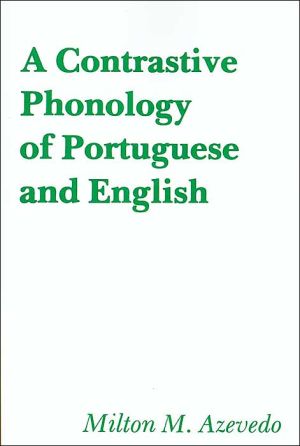A Contrastive Phonology Of Portuguese And English
Compares the sounds, phonology, and prosody of General American English and Southeastern Brazilian Portuguese.
Search in google:
This study analyzes passive sentences in English and Portuguese which result from a postsemantic transformation applied when a noun, which does not play the semantic role of actor, is chosen as syntactic subject. Choice between a passive and its non-passive or active counterpart reflects differences in the distribution of information in the sentence as regards the relative importance of the latter's constituents for communication. Such distribution is analyzed in terms of Prague school theory, especially that involving the notions of communicative dynamism and the distribution of theme and rheme. Portuguese sentences with the indeterminate pronoun se are analyzed here as the surface marker of an incompletely specified semantic actor. While such sentences overlap semantically with passives, they are structurally different from them and thus should not be considered a special type of passives. The concluding part of the book presents a contrastive analysis of English and Portuguese passive sentence patterns. This contrastive analysis serves as the basis for observations on the teaching of Portuguese passives to native speakers of English.
1Introduction11.1Introduction11.2Phonological description11.3Contrastive analysis and foreign language acquisition61.4Acknowledgments72The Sounds of Portuguese92.1Introduction92.2Vowels92.3Vowel reduction122.3.1The lower mid vowels122.3.2Other vowels132.4Diphthongs and triphthongs172.5Nasalization232.6Consonants282.6.1Phonetic realization of consonants312.7Syllable types373The Sounds of English413.1Introduction413.2Syllabic nuclei413.2.1Vowel reduction453.3Consonants473.3.1Phonetic realization of consonants493.4Syllable types554Comparison of Phonological Units574.1Introduction574.2Portuguese vowels vs. English vowels584.3Portuguese vowels and falling diphthongs vs. English syllable nuclei594.3.1Portuguese /i/ vs. English /i/ and /t/594.3.2Portuguese /e/, /ei/ vs. English /e/604.3.3Portuguese /e/, /[varepsilon]/ vs. English /[varepsilon]/, /ae/614.3.4Portuguese /a/ vs. English /a/, /[Lambda]/624.3.5Portuguese /ai/, /au/ vs. English /ay/, /aw/634.3.6Portuguese /[characters not reproducible]s. English /[characters not reproducible]644.3.7Portuguese /o/, /ou/ vs. English /o/644.3.8Portuguese /[characters not reproducible]/oi/ vs. English /[characters not reproducible] Portuguese /[characters not reproducible]/ei/ vs. English /e/654.3.9Portuguese /u/ vs. English /u/, /[characters not reproducible]664.3.10Portuguese diphthongs without counterparts in English674.3.11Portuguese diphthongs formed by vowel + /l/674.4Portuguese rising diphthongs and triphthongs vs. English consonant + vowel or diphthong684.5Unstressed vowels694.6Portuguese nasal vowels and diphthongs vs. English vowel + nasal consonant714.7Portuguese consonants vs. English consonants724.7.1Comparison of consonantal phonemes745Comparison of Phonological Sequences815.1Introduction815.2Transition phenomena815.3vowel sequences845.4Consonant sequences865.5Consonant + vowel sequences895.5.1/n/ + vowel895.5.2/r/ + vowel905.5.3/l/ + vowel905.5.4/s/ + vowel905.6Postnuclear sequences906Prosody926.1Introduction926.2Stress926.3Pitch and sentence stress956.4Intonation patterns986.4.1Statement patterns: Ptg. (1) 2 1 [down arrow], (1) 2+ 1 [down arrow]; Eng. (2) 3 1 [down arrow]986.4.2Yes/no questions: Ptg. (1) 2 2+ [up arrow], Eng. (1) 2 3 [up arrow]1016.4.3Questions with interrogative words: Ptg. (1) 2 1 [down arrow]; Eng. 2 3 1 [down arrow]1026.4.4Greetings: Ptg. 2 1 [down arrow], 2 2 [down arrow], 1 2 1 [down arrow], 2 3 1 [down arrow]; Eng. 2 3 1 [down arrow], 2 3 1 [up arrow]1036.4.5Contrastive statements: Ptg. (1) 2 3 1 [down arrow]; Eng. (1) 2 4 1 [down arrow]1046.4.6Sequences: Ptg. (1) 2 [rgiht arrow] 2 [right arrow] 1 [down arrow], (1) 2 [up arrow], 2 [up arrow], 1 [down arrow]; Eng. (2) 3 [right arrow] 3 [right arrow] 3 1 [down arrow]; 2 [up arrow] 2 [up arrow] 3 1 [down arrow]105References109








